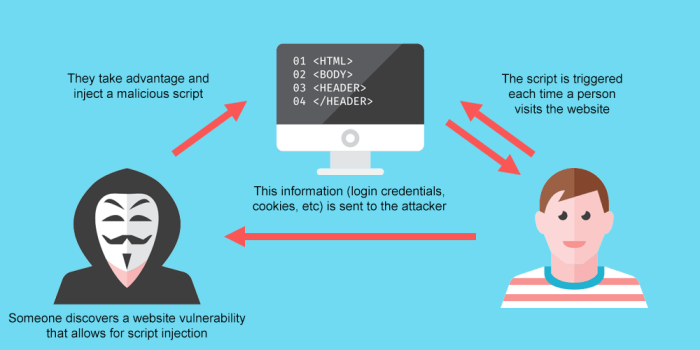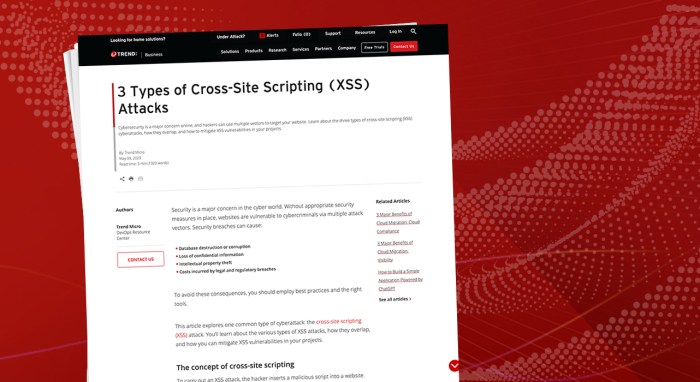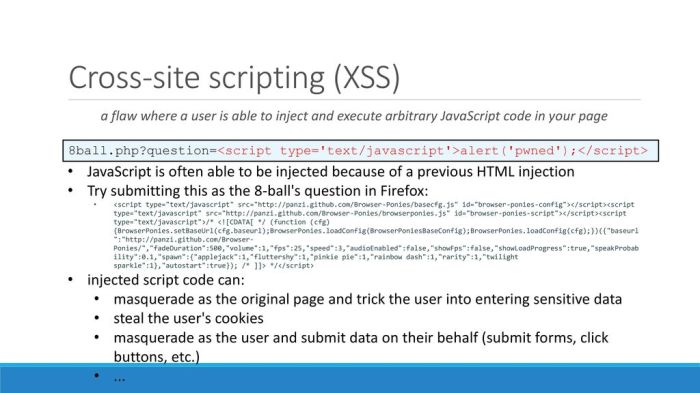Hackers exploiting Roundcube XSS vulnerability? Yeah, it’s a bigger deal than you think. This seemingly niche webmail flaw opens a Pandora’s Box of potential disasters for unsuspecting users and businesses alike. We’re diving deep into how hackers leverage this weakness for data theft, session hijacking, and more – unpacking the methods, the impact, and crucially, how to prevent becoming the next victim.
Imagine your inbox, the digital heart of your professional and personal life, suddenly compromised. That’s the reality of a successful Roundcube XSS attack. We’ll dissect the different types of XSS vulnerabilities, explore real-world examples (without naming names, of course!), and provide practical, actionable steps to secure your Roundcube setup. Get ready to boost your digital defenses.
Roundcube XSS Vulnerability Overview
Roundcube, while a popular and generally secure webmail solution, isn’t immune to vulnerabilities. Like any complex software, it can contain weaknesses that malicious actors can exploit. Understanding these vulnerabilities, particularly Cross-Site Scripting (XSS) flaws, is crucial for administrators to secure their systems and users to protect themselves. This overview focuses on common XSS vulnerabilities found in Roundcube and strategies to mitigate them.
Cross-Site Scripting (XSS) vulnerabilities are a serious threat in web applications, allowing attackers to inject malicious scripts into otherwise trusted websites. In the context of Roundcube, this means attackers could potentially steal user credentials, session cookies, or even gain control of the user’s entire account. The impact depends heavily on the specific vulnerability and the attacker’s goals.
Types of XSS Vulnerabilities in Roundcube
Roundcube, like many webmail clients, is susceptible to several types of XSS attacks. These include reflected XSS, stored XSS, and DOM-based XSS. Reflected XSS occurs when an attacker crafts a malicious URL containing JavaScript code, which is then reflected back to the user’s browser. Stored XSS, also known as persistent XSS, involves injecting malicious code into the Roundcube database, such as within user profiles or messages. This code is then executed whenever a user views the affected content. DOM-based XSS targets the Document Object Model (DOM) of the browser, manipulating the page’s content directly within the user’s browser.
XSS Attack Vectors, Impact, and Mitigation in Roundcube
Understanding the different attack vectors is key to implementing effective mitigation strategies. The following table illustrates several potential XSS vulnerabilities in Roundcube, their consequences, and how to prevent them.
| Attack Vector | Impact | Mitigation | Example Code Snippet (Illustrative) |
|---|---|---|---|
| Reflected XSS in Search Functionality | Attacker could inject a script into the search query, redirecting users to a phishing site or stealing cookies when a user clicks a search result. | Properly sanitize and escape all user input before displaying it on the page. Use parameterized queries instead of string concatenation. | |
| Stored XSS in User Signatures | Malicious JavaScript in a user’s email signature could execute when another user views the email, potentially compromising their session. | Sanitize and escape all user-provided content, including email signatures, before storing it in the database. Implement input validation to prevent the injection of malicious scripts. | |
| DOM-based XSS in Email Composition | An attacker might exploit vulnerabilities in the email composition interface to inject scripts that execute in the user’s browser, potentially stealing data from the email client itself. | Use a robust content security policy (CSP) to restrict the execution of external scripts and resources. Thoroughly review and test the client-side JavaScript code for vulnerabilities. | Malicious JavaScript injected directly into the email body, manipulating the DOM to steal information. (Specific example depends on the exact vulnerability) |
| Stored XSS in Displaying Untrusted Emails | If Roundcube doesn’t properly sanitize emails received from external sources, malicious scripts within the email body could be executed. | Employ robust email sanitization techniques to remove or neutralize potentially harmful scripts before displaying emails. Consider using a dedicated email sanitization library. | |
Hacker Exploitation Methods
Exploiting a Roundcube XSS vulnerability allows attackers to inject malicious scripts into the web application, potentially gaining unauthorized access to user data and sessions. This process, while seemingly technical, can be broken down into a series of steps that illustrate the danger posed by these vulnerabilities.
The core of the exploitation lies in crafting and delivering a malicious payload, often disguised within seemingly harmless content. Once a vulnerable user interacts with this payload, the attacker gains control, potentially compromising the user’s session and accessing sensitive information. The severity depends heavily on the specific vulnerability and the attacker’s skills.
Malicious Payload Examples, Hackers exploiting roundcube xss vulnerability
Attackers utilize various malicious payloads designed to execute arbitrary JavaScript code within the Roundcube webmail interface. These payloads can range from simple alerts to sophisticated data theft mechanisms. A common example might involve embedding a script that redirects the user to a phishing website, stealing their credentials. Another could be a script designed to steal cookies containing session information, granting the attacker complete access to the user’s account. More advanced attacks could even involve exfiltrating email content or contact lists. For instance, a payload might look like this: onerror attribute, revealing the user’s cookies in a popup alert. A more sophisticated attack would replace the alert function with code that sends the cookie data to a remote server controlled by the attacker.
Bypass Techniques
Hackers often employ techniques to bypass security measures implemented to prevent XSS attacks. These might include encoding or obfuscating the malicious script to evade detection by web application firewalls (WAFs) or input sanitization routines. They may also exploit vulnerabilities in the way Roundcube handles specific data types or utilizes third-party libraries. For example, an attacker might use techniques like HTML entity encoding to mask malicious characters, or leverage browser quirks to circumvent security filters.
Session Hijacking and Data Theft
Successful exploitation of a Roundcube XSS vulnerability can lead to both session hijacking and data theft. By stealing session cookies, attackers gain access to the user’s account, allowing them to read, send, and delete emails, as well as access other sensitive information associated with the account. Data theft might involve stealing contact lists, email content, or other personal data stored within the user’s Roundcube environment. The attacker might then use this stolen information for identity theft, phishing campaigns, or other malicious activities.
Hypothetical Attack Scenario
Imagine a scenario where an attacker discovers an XSS vulnerability in Roundcube’s user profile editing section. They craft a malicious payload disguised as a harmless profile update instruction – perhaps a link to a seemingly helpful guide. A user, believing the link to be legitimate, clicks it. The payload executes, silently stealing the user’s session cookie. The attacker then uses this cookie to log into the user’s account, gaining access to all their emails and contacts. The user remains unaware of the compromise until they notice suspicious activity, such as emails being sent without their knowledge or changes to their contact list. The consequences could range from reputational damage and loss of privacy to financial loss if the compromised account is used for fraudulent activities.
Impact and Consequences of the Exploit

Source: wpexplorer.com
A successful Cross-Site Scripting (XSS) attack on a Roundcube webmail server can have far-reaching and devastating consequences, impacting both individual users and the organization as a whole. The severity depends on the nature of the injected script and the level of access the attacker gains. Ignoring the potential fallout can lead to significant financial losses and irreparable damage to reputation.
The consequences stem from the attacker’s ability to execute malicious JavaScript code within the context of a legitimate user’s session. This allows the attacker to manipulate the user interface, steal sensitive information, and potentially gain control over the affected accounts.
Data Compromise
An XSS vulnerability allows attackers to steal various types of sensitive data. This includes email content, contact lists, account credentials (passwords, usernames), session cookies, and any other data displayed within the Roundcube interface. For instance, an attacker could inject a script that silently copies all emails from an inbox or extracts details from contact lists. The impact extends beyond personal data; business-critical information like financial records, client communications, and internal memos could also be compromised, leading to severe repercussions.
Impact on User Privacy and Security
The privacy and security of users are severely compromised by a successful XSS attack. Stolen credentials can grant attackers complete access to users’ accounts, allowing them to send fraudulent emails, impersonate users, and access sensitive information. The attacker could also use the compromised account to launch further attacks, turning the victim into an unwitting accomplice in broader cybercrime. Consider the scenario where a company’s CEO’s account is compromised, leading to the dissemination of false information or the sending of malicious phishing emails to employees or clients.
Business Disruptions
A Roundcube XSS exploit can cause significant business disruptions. These disruptions can include:
- Service Interruption: The attacker might disrupt email services by injecting scripts that overload the server or make the interface unusable. This can bring operations to a standstill.
- Data Breaches: As mentioned, sensitive data loss can lead to regulatory fines (like GDPR penalties), legal action from affected users, and loss of customer trust.
- Reputational Damage: News of a data breach can severely damage a company’s reputation, potentially leading to a loss of customers and business partners.
- Lost Productivity: Employees may spend considerable time dealing with the aftermath of the attack, such as changing passwords, investigating the extent of the breach, and responding to customer inquiries.
- Increased Security Costs: The company will likely incur significant costs related to investigating the breach, remediating the vulnerability, enhancing security measures, and potentially engaging legal counsel.
Financial and Reputational Damage
The financial consequences of a Roundcube XSS attack can be substantial. Direct costs include remediation efforts, legal fees, regulatory fines, and potential compensation to affected users. Indirect costs can be even more significant, including lost revenue due to service disruption, damage to reputation leading to customer churn, and the cost of regaining customer trust. For example, a large company experiencing a data breach that exposes customer financial information could face millions of dollars in fines and legal settlements, not to mention the long-term impact on its brand and market share. The reputational damage can be equally devastating, with long-lasting effects on the company’s ability to attract investors and retain customers.
Prevention and Mitigation Strategies
So, you’ve learned about the nasty XSS vulnerabilities lurking in Roundcube. Now, let’s talk about how to stop them before they become a major headache. Preventing these attacks isn’t about building an impenetrable fortress; it’s about layering defenses to make it significantly harder for attackers to succeed. Think of it like a Swiss cheese model – even if one layer fails, others are there to catch the threat.
Protecting your Roundcube installation from XSS attacks requires a multi-pronged approach. It’s a combination of proactive measures, diligent maintenance, and a dash of user education. Neglecting any one of these areas significantly weakens your overall security posture.
Input Validation and Output Encoding
Input validation is your first line of defense. This involves meticulously scrutinizing any data received from users before it’s processed by the Roundcube application. This includes sanitizing and filtering user inputs to remove or neutralize potentially harmful characters and code. Think of it as a bouncer at a club, carefully checking IDs and preventing troublemakers from entering. Output encoding, on the other hand, ensures that any data displayed to users is properly escaped. This means converting special characters into their HTML entities, preventing them from being interpreted as executable code. This is like having a security guard at the club ensuring no one sneaks in contraband. Implementing both input validation and output encoding is crucial; relying on only one leaves a significant vulnerability. For example, validating input prevents malicious scripts from being submitted in the first place, while output encoding prevents the display of already existing, potentially harmful data in a way that can be executed.
Regular Software Updates and Security Patches
Staying up-to-date is non-negotiable. Regularly applying security patches and updates from Roundcube’s developers is paramount. These updates often contain critical fixes for known vulnerabilities, including XSS flaws. Think of it like getting your flu shot every year; it’s a proactive measure that significantly reduces your risk. Ignoring updates leaves your system exposed to known exploits, making it a prime target for attackers. The Roundcube project maintains a changelog and release notes; diligently review these to understand the security improvements included in each update. Delaying updates, even for a short time, can have serious consequences.
User Education
Educating your users about the dangers of phishing, malicious links, and suspicious emails is crucial. They are often the weakest link in your security chain. Users should be trained to recognize and avoid suspicious emails or links that might lead to malicious websites. Think of this as community watch for your email system. Providing clear and concise guidelines on safe email practices can significantly reduce the likelihood of successful XSS attacks. Regular security awareness training can significantly enhance your overall security posture by making users a more informed and vigilant part of the defense.
Hardening Roundcube’s Security Configuration
Implementing these recommendations can substantially enhance your Roundcube’s security:
- Enable strong password policies: Enforce complex passwords with minimum length requirements, character diversity, and regular changes.
- Utilize two-factor authentication (2FA): Add an extra layer of security by requiring a second verification method, such as a one-time code from a mobile app.
- Restrict access based on roles and permissions: Limit user access to only the necessary functionalities.
- Regularly audit security logs: Monitor system logs for suspicious activity and promptly investigate any anomalies.
- Implement a web application firewall (WAF): A WAF can filter malicious traffic and block known attack patterns before they reach your Roundcube server.
- Use HTTPS: Encrypt all communication between clients and the server to prevent eavesdropping and man-in-the-middle attacks.
Case Studies and Real-World Examples: Hackers Exploiting Roundcube Xss Vulnerability

Source: trendmicro.com
Understanding the real-world impact of Roundcube XSS vulnerabilities requires examining specific instances where these weaknesses were exploited. While details of specific incidents are often kept confidential for security reasons, analyzing general patterns reveals crucial insights into hacker tactics and the resulting damage. The following examples illustrate different approaches used by attackers and the subsequent consequences.
Exploit Case 1: Compromised Email Accounts and Data Theft
In one instance, an attacker leveraged a Roundcube vulnerability to inject malicious JavaScript code into an email’s subject line. This code, when viewed by a user, allowed the attacker to steal session cookies. These cookies granted the attacker access to the victim’s email account, providing access to sensitive information such as personal correspondence, financial details, and login credentials for other online services. The attacker then used this compromised access to send phishing emails to the victim’s contacts, expanding the attack’s reach. The impact was significant, leading to financial losses, reputational damage, and a major security breach for the affected organization. The vulnerability stemmed from insufficient input sanitization within the Roundcube application, allowing the attacker’s malicious code to bypass security measures.
Exploit Case 2: Website Defacement and Data Manipulation
Another case involved an attacker exploiting a Roundcube vulnerability to inject malicious code into the Roundcube web interface itself. This allowed the attacker to deface the email client’s interface, replacing legitimate content with their own messages and images. Beyond the obvious reputational damage, the attacker also managed to manipulate user data, altering email settings and potentially redirecting email traffic to their own servers. The vulnerability in this instance was due to a lack of proper output encoding, allowing the attacker’s script to execute within the user’s browser. The consequences included loss of user trust, potential legal repercussions, and the significant cost of remediation and restoring the system’s integrity.
Exploit Case 3: Targeted Phishing and Malware Distribution
A third example highlights a more targeted attack. Hackers identified a vulnerability in a specific Roundcube plugin or a custom theme, allowing them to inject malicious code that would only activate under certain conditions. This code, once activated, redirected users to a phishing website designed to steal credentials or downloaded malware onto the victim’s computer. The attacker’s sophisticated approach allowed them to target specific users or groups within an organization, maximizing their chances of success. The impact included not only compromised accounts but also potential infection of internal systems with malware, leading to further data breaches and operational disruptions. This attack showcased the danger of poorly maintained plugins and custom code, which often introduce additional security risks.
Conclusive Thoughts

Source: slideplayer.com
So, hackers exploiting Roundcube XSS vulnerabilities are a serious threat, but not an insurmountable one. By understanding the attack vectors, implementing robust security measures (like input validation and regular updates!), and educating users, we can significantly minimize the risk. Remember, proactive security is cheaper than the fallout from a data breach – so get patching and stay vigilant!





